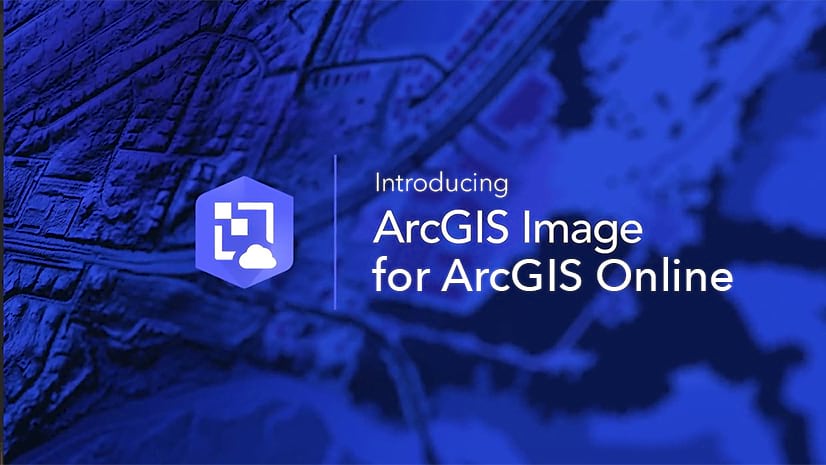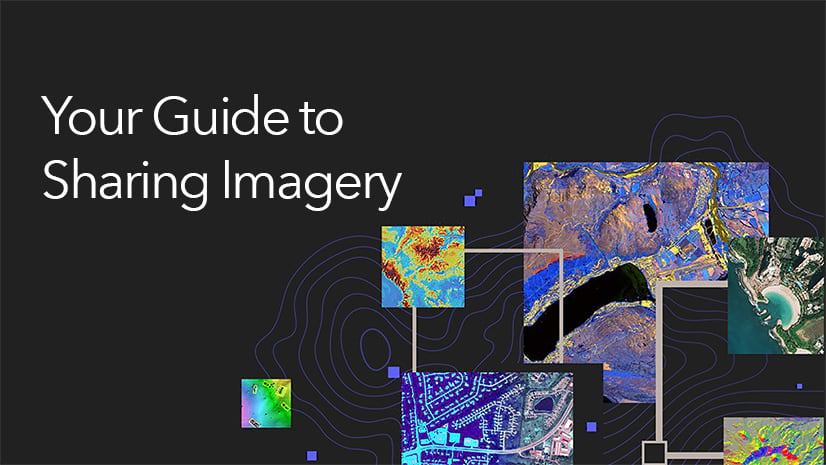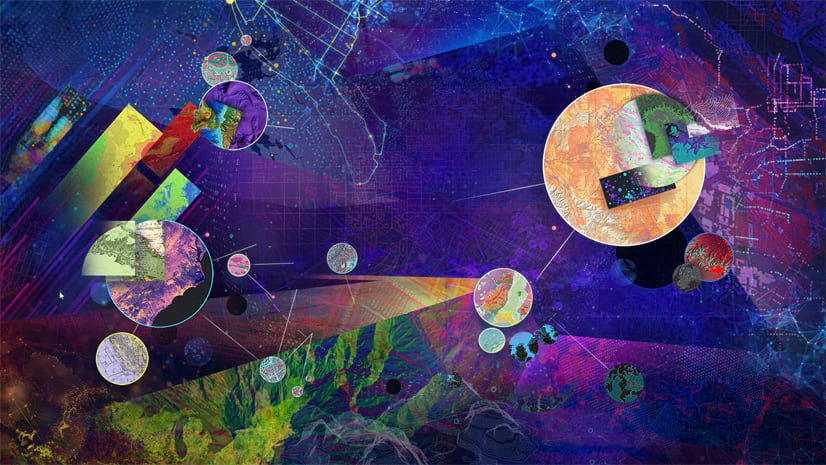From October 5-8, 2021, thousands of professionals from across the nation came together for USGIF’s annual GEOINT Symposium. We were all connected by a common passion for the way geospatial intelligence adds context to our world and those four days reminded me of how wonderful it can be to learn from one another and collaborate in person. Also, in preparing for another event this week, Esri’s Imagery Summit, I have been reflecting on the key takeaways from GeoINT and how we use this insight to better support our own GIS and Imagery users.
Having worked in the remote sensing industry for the better part of three decades now I was struck by what was a clear shift back to our roots in earth observation, as well as the elevation of the conversation around remote sensing’s increasing role in traditionally non-spatial analytics. Here are my top three takeaways and areas to keep an eye on post-GEOINT 2021.
1) Integrating Structured and Unstructured Data.
I think we can all agree that the predictions of the last decade around big data analytics were largely accurate; however, as businesses, governments, and agencies we are just now starting to realize the power of bringing different sources and forms of data together into a single ecosystem to enable deeper and richer analytic insights. As someone who focuses on geospatial data, I am most excited to see the progress we are making in showing the world the power of understanding these traditionally unstructured data sources in spatial context. There are still challenges ahead of us. As we see the number of sensors around the world continue to grow exponentially, data is becoming more and more voluminous, putting an immense amount of pressure onto data scientists and analysts to take this abundant data and turn it into meaningful information. Making sense of so much data, particularly in a timely manner, can quickly become overwhelming. Add to this the idea of the convergence of remote sensing data with unstructured data sources and the complexity multiplies.
Unstructured data like digital media files, tabular data or documents while very immersive and information rich, become so much more valuable when understood in geospatial context. Natural language processing can help find place names in text, and not only link those locations to a map, but also help analysts find patterns of relationship that might not have otherwise been detectable. Those insights would otherwise have been lost in the text. You can also use an oriented imagery catalog to click through and see exactly what a given location looked like on the ground, pull-up a video clip, or connect data-rich documents to the location – all to help enrich the human understanding of those other layers within context. This can also help capture sentiment in a region such as during times of social protest, bringing in live photos from the event in question.
The rewards of this hard work are potentially vast. Not only do we enable a better understanding of the spatial relationships between data elements, by aggregating, connecting, and converting many different data types, we can now see the world’s interdependent social, economic, and environmental ecosystems in the holistic manner that is required to address some of our most pressing challenges. Now we can see the world multidimensionally, extending the paradigm beyond x, y and z to add time (t) and relationships (r). This will enable a much more powerful and informed decision-making process and not only give us a truer picture of what’s happening on the ground, but it will also start to answer the questions of “where” and “why” as well.
2) Supporting sustainability efforts with innovative applications of remote sensing
SAR Data
GEOINT 2021 also reinforced just how prominent Synthetic Aperture Radar (SAR) data is becoming for both monitoring and analytic applications. While the tech has been around since the 1950s, it has only recently been gaining popularity due to its unique ability to create a highly accurate picture both during the day, at night, and through smoke and cloud cover. This makes it especially useful for analysts who are seeking to gain a more holistic picture of what’s happening. So, whether it’s a local emergency management situation like the oil spill off the coast of California or to monitor global issues like deforestation this technology can be very powerful in helping see areas when more traditional sensor types cannot.
Some organizations that stood out to me are Capella Space, with their unparalleled 50 cm x 50 cm resolution imaging, Umbra Lab who has a special patent for their unique antenna, PredaSAR with their ambitions of launching a large constellation of larger class satellites to truly give us persistent monitoring capabilities, and ICEYE who produces SAR-based products from sentinel-1 and SPOT data. The work on SAR data processing is almost making great strides in moving this important phenomenology out of realm of the exotic and into the mainstream as well.
Hyperspectral Imaging
Up until now, most greenhouse gas emissions have largely been tracked through terrestrial monitoring stations spread out around the globe, often near large methane or carbon emitting facilities. While these are great, and have grown tremendously over the past decade, they are limited in coverage. For context, a map of FLUXNET locations can be seen here. However, by now using spaceborne hyperspectral sensors on satellites we can now get monitoring with a wider view of the planet with capabilities to detect phenomena not available on current spaceborne assets. Especially as the world is coming together to address the climate crisis, remote sensing professionals are being called upon to ascertain what’s detectable and create the best workflows to provide persistent coverage to monitor methane and carbon in the atmosphere. CarbonMapper, Satellogic, and GHGSat are leading the way with planned hyperspectral capabilities that will solve problems with greater confidence.
3) The next wave of satellites will be larger and provide higher resolution imagery
Finally, GEOINT 2021 showed a clear return to our roots in earth observation. From the mid-2000s to the late 2010s the future seemed to be large constellations of small satellites. Cheaper to build, cheaper to launch, cheaper to operate, and easier to get new innovations into orbit faster. We had convinced ourselves that temporal resolution needed to take priority over spatial resolution and, in some cases, accuracy and image quality. Based on the number of newly planned constellations, from both startups and established players, we are seeing a clear move back to building larger satellites, and more of them, with higher resolution, better quality, and increased re-visit time. In somewhat of a “goldilocks” moment for our industry, imagery providers appear to be finding efficiencies to achieve a good middle ground between satellites the legacy large bus exquisite systems and the small satellites. To be clear, small satellites will continue to have their place, and of course there will still need to be some exquisite systems, but I was encouraged by the movement to better balance temporal and spatial resolution and a renewed focus on quality and accuracy. Some of the companies and organizations to keep an eye on that are heading this direction:
- NASA just launched LandSat 9 with 30-meter coverage and a mission to better monitor climate.
- Airbus Pleiades Neo – Recently launched with 30cm resolution.
- Planet’s recently announced Pelican, a new fleet of high-res satellites to be launched next year.
- PredaSAR has an ambitious plan for a large constellation of medium class SAR satellites that will provide persistent monitoring
- Maxar and Airbus are both upping their game with best in class optical systems that will going to deliver very high spatial resolution more frequently.
Conclusion
Stepping out of the 2021 GEOINT conference I’m inspired and ready to optimize the way we support our customers in their journey to unlocking the power of imagery and inspiring action. I feel a responsibility working here at Esri, the leader in geospatial technology, to provide comprehensive, scalable, and resilient software to help enable that greater understanding of our world in space, time, and across contextual relationships. Whether this be at the local or national level, imagery has the ability to drive change for the global good. Want to explore the latest developments specific to remote sensing, imagery, big data analytics, and visualization? No-cost registration for digital access to the 2021 Esri Imagery Summit is open to all Esri customers who are current on their maintenance or subscriptions until November 16th. Register here.





Commenting is not enabled for this article.